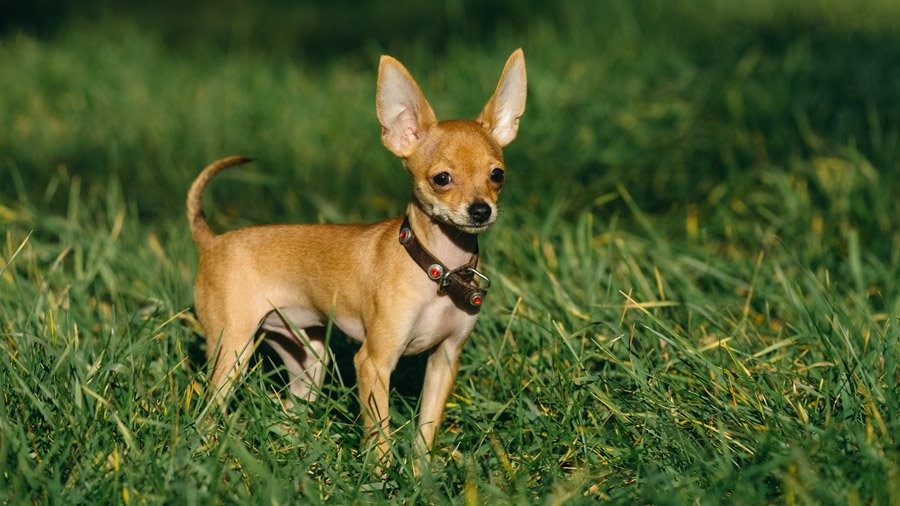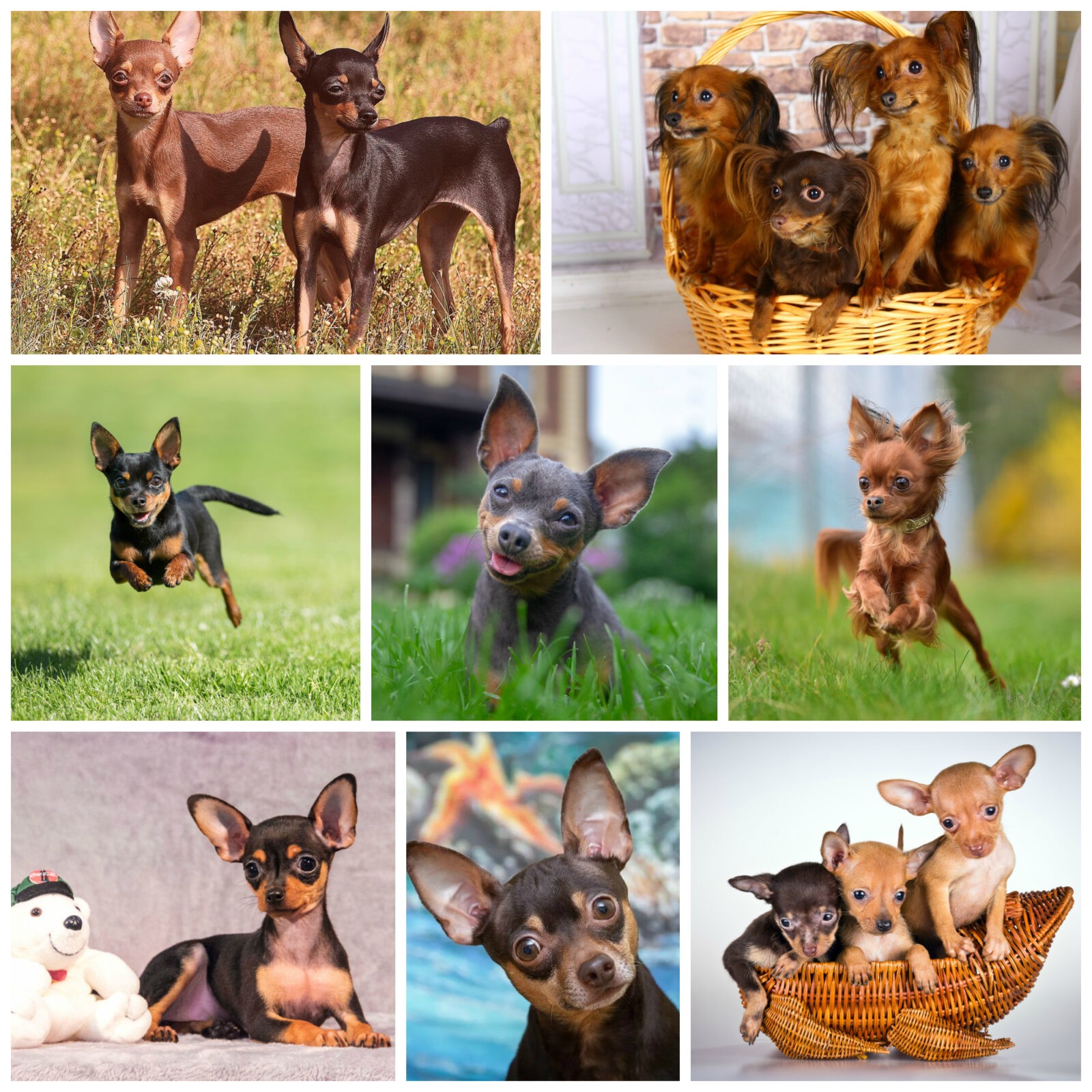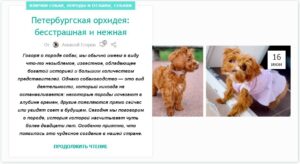
Brief description of the breed Russian Toy Terrier
The most common shade of toy terrier coat is black and tan, but there are also brown, red, blue and lilac colors (with and without tan). The Russian toy terrier breed is divided into two types - smooth-haired and long-haired. Smooth-haired Russian Toy Terriers have a short coat without undercoat, in comparison with their "fluffy" counterparts, their figure seems to be more toned. Long-haired toy terriers are distinguished by the presence of long hair on the ears, tail (if it has not been docked) and paws.
The complexion of the breed is lean and graceful, these dogs are high on their legs, have straight, parallel limbs. The muzzle of Russian toy terriers is small, wedge-shaped, it is decorated with erect ears in the form of a regular triangle of a rather large size (compared to the size of the head).
An interesting fact is that bitches of this breed, although they are affectionate and devoted to the owner, remember insults for a long time, they are more jealous of the owner than males. Like true women, Russian toi girls never lose their self-esteem and show their temper if they don’t like something. There is a debate about which of the Russian Toy - girls or boys - are man's best friends. And, of course, opinions are divided. In appearance, both sexes of these small dogs are very similar to each other.
Owner reviews:
basic information
| Breed name: | Russian toy terrier |
| Country of origin: | Russia |
| The time of the birth of the breed: | 20th century |
| Type of: | decorative and companion dogs |
| The weight: | up to 3 kg |
| Height (height at the withers): | 20 - 28 cm |
| Life Expectancy: | 15 – 18 years old |
|
ICF classification:
|
Group 9, Section 9, Number 352 |
| Puppies price: | 100 – 1000 $ |
| Most popular nicknames: | list of nicknames for russian toy terrier |
Evaluation of the characteristics of the Russian Toy Terrier breed
| Adaptability
(a definition meaning how easily a dog can adapt to changes in life) |
🐶🐶🐶🐶 |
| Shedding level
(Level and frequency of hair loss in the animal) |
🐶🐶 |
| Tenderness level
(The level and amount of tenderness and affection that the dog gives in return for attention to itself) |
🐶🐶🐶🐶🐶 |
| Exercise needs
(Dog's daytime activity level) |
🐶🐶🐶 |
| Social need
(The required number of contacts of the dog with other animals, as well as people) |
🐶🐶🐶🐶 |
| Apartment content
(A factor that determines the level of noise and other inconveniences that a dog can deliver to owners in relation to the size of the apartment to the size of the dog) |
🐶🐶🐶🐶🐶 |
| Grooming
(The number of bathing, brushing, and the number of professional grooming sessions required for the dog) |
🐶🐶 |
| Friendliness in an unfamiliar environment
(Features of the behavior of a dog in a society with strangers or in an unfamiliar environment) |
🐶🐶🐶 |
| Tendency to bark
(Tendency to bark and its frequency and volume) |
🐶🐶🐶 |
| Health issues
(Potential health status of the dog) |
🐶🐶 |
| Territoriality
(The dog's tendency to protect his home, yard, or even his owner's car) |
🐶🐶🐶 |
| Friendliness to cats
(The tendency towards tolerance for cats and decreased manifestation of hunting instincts) |
🐶🐶🐶🐶 |
| Intelligence
(The ability of the dog to think and solve emerging difficulties (not to be confused with learning!) |
🐶🐶🐶 |
| Education and training
(The level of difficulty in training the dog to perform certain actions) |
🐶🐶🐶 |
| Friendliness to children
(A factor that determines how friendly a dog is to children, whether he likes to play with them and tolerate some childish pranks) |
🐶 |
| Game activity
(The concept is determined by its very name, and, as a rule, is found in almost all dogs) |
🐶🐶🐶🐶 |
| Observation
(The ability of a dog to detect the presence of a stranger on its territory) |
🐶🐶🐶 |
| Friendliness to other dogs
(The tendency of the dog to find common language with his other relatives) |
🐶🐶🐶 |
Russian toy terrier photo:

Origin story
The ancestors of Russian toys are miniature English toy terriers, which began to appear in the Russian Empire from the end of the 19th century. Their small size, unpretentious care and docile nature made English toy terriers favorites of the nobility. But the October Revolution of 1917 intervened in the state of affairs, which practically led the dog population to extinction. This state of affairs was due to the fact that large service dogs were required, and there was no place for decorative dogs in the new country.
The idea of creating a breed originated in the minds of the metropolitan breeders in the early 50s. Due to a significant decrease in the number of English toy terriers, mating often occurred between individuals with defects (colors, structures, etc.). This led to the fact that the direct descendants of the British - Russian Toy Terriers are so strikingly different from their foreign counterparts. By the way, smooth-haired toy terriers originally appeared. In the 80s, Russian toys began to lose their popularity due to the imported "fashionable" decorative dogs of other breeds. But in the next decade, the situation stabilized, and toy terriers took their niche in the ranks of dog lovers.
An interesting fact is that the English Toy Terrier breed standard specifies only one acceptable shade of coat - black and tan, while their Russian relatives often have other colors. Today, English Toy Terriers are considered a relatively rare breed, while Russian Toy Terriers, bred in Moscow at one time, are popular and often found both in our homeland and abroad.
The nature of the Russian toy terrier
Maintenance and care
Easy to care for, Russian Toy Terriers can be great companions for adults and busy people due to their compact size and ease of care. In families where small children live, Russian Toy Terriers can grow up to be overly excitable, and also be traumatized by a child, not out of a sense of evil, but for the sake of curiosity.
The residence of these obstinate kids is possible only in a well-lit room, without drafts. Toy Terriers, like large dogs, they love walks very much, but in case of bad weather or while the animal is not yet accustomed to the house, constant exits outside the walls of the house, you can equip a specially designated place (a dog tray in which you can lay an absorbent diaper or artificial grass). The first time, when the animal just appeared in the house, you should remove the carpets, spreading the diapers, which should gradually (when the dog understands why the owner has laid them) move to the place that will be dog toilet.
Hair care for the smooth-haired terrier is minimal - bathing as it gets dirty, timely prevention of bloodsucking. Long-haired toy terriers require more careful care - combing out dead hairs with special brushes.
It is advisable to purchase toys for a house friend. Squeaker toys are not bad and interesting for the dog - rubber bones, balls (smooth, without spikes, of medium size, so that the dog during the game cannot swallow the product or a piece bitten off from it). It is undesirable to give as toys those products that are intended for cats. Even the miniature size of toy terriers still does not make his teeth weak. And the small size of the stomach can lead to the need for surgery. Soft plush toys are fraught with malocclusion. If the animal really wants to please a soft friend, you should choose a fabric (or with a small pile) toy, after making sure that the nose, eyes and other details are sewn or glued tightly.
As feeding, you can choose both ready-made dry and canned food, and cook your own dog food. In the event that a dog owner decides to buy industrial products for a pet, those types that are designed for dogs of miniature breeds should be preferred. Natural food for a toy terrier should be 2/3 meat (including offal). The diet should contain dairy products, eggs. Kashi (mixed with meat) should alternate with boiled vegetables (also with meat). When feeding your own food, you should think about fortifying the animal in the autumn and spring periods.
Adult dogs should receive food at least 2 times a day, and puppies up to 3-4 months at least 4-5 times. Cleanliness of bowls is very important, dirty bowls can disrupt the dog's digestive tract. It is advisable to change the water daily, and wash the bowl after feeding.
By the way, between the owners of toy terriers there are often disputes about the age when an animal can be purchased from a breeder. The advantages of small toy terriers are that such dogs can be brought up to your liking, but an older individual can show character. It is worth relying not only on the call of your heart, but also soberly assess the general condition of the dog, as well as the conditions of his living with his mother. Warnings that may require long-term treatment: weak joints, profuse discharge from the nose and eyes, apathetic behavior, inflammation in the ears or eyes. In a word, all the symptoms of ill health must be taken into account. It is also worth paying attention to the nature of the dog - an overly aggressive (as well as very shy) puppy may not take root in the family. Minor flaws may be acceptable in cases where the puppy is not purchased for participation in exhibitions and divorce.
Training and education of dogs of breed Russian toy terrier
Health and disease
The main weak points of these dogs are the teeth and the musculoskeletal system. Dog bones need to be nourished with vitamins. Also, dogs are often injured by the owners themselves, who have not calculated their own strength and fragility of the animal. Dog teeth should also be given due attention, to monitor the presence of tartar, which has a destructive effect on the condition of the teeth and gum health. Inflamed gums are an open gateway for infection.
Even for those dogs that spend most of their time in an apartment, it is advisable not to forget to vaccinate against rabies, enteritis and distemper. Often, owners are offered a comprehensive vaccination not only against these three serious diseases, but also against rhinotracheitis, adenovirus, leptospirosis. The choice is better to make in favor of imported vaccines, since they usually have fewer side effects. Before vaccination, it is necessary to carry out deworming and prevention of skin parasites, make sure that the animal is completely healthy on the eve of vaccination.
Some interesting facts
- The very name of these dogs almost completely repeats another breed "English toy terrier", adjusted for the territoriality of its creation. In a free translation, the Russian toy terrier is “Russian toy burrowing dog”. This is due to the fact that the ancestors of the heroes of this article are to this day not only an integral part of fashionistas, but also excellent hunters of small burrowing animals.
- As a rule, females of Russian Toy are characterized by small pregnancies (no more than 3-5 puppies). Relatively fragile and small in size, toy terrier girls can bring only 1 baby.
- These dogs are sometimes confused with miniature pinschers (pygmy pinschers), which are really similar to Russian toys both in color and in structure, but they are more muscular, a little larger and taller. Although, in fact, these two breeds do not have common blood.
- Often the owners of Russian toys do not pay attention to training, and if they wish, they can even perform complex commands and tricks. It is the lack of training and the attitude of the owner to the dog as to a toy that can spoil animal. Unrestrained barking for no reason, throwing at people and dogs large build - all these shortcomings symbolize not so much the scandalous temper of the toy as the lack of due attention of the owner to training.
Nurseries and breeders
We borrowed material from the wonderful site of our partners DOGCATFAN.COM about cats and dogs, the author dogcatfan

